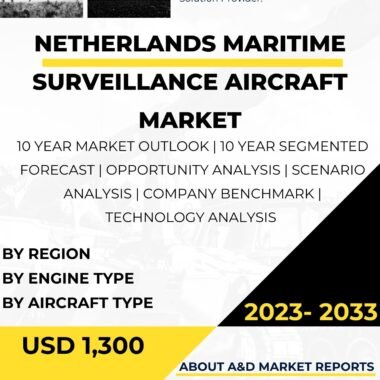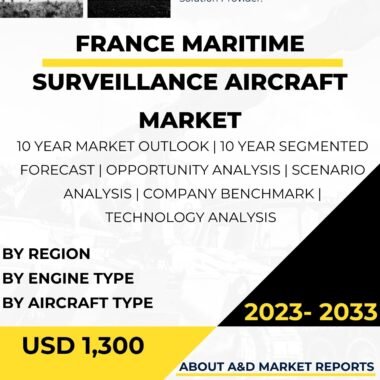Description
The India Maritime Surveillance Aircraft market is a vital and growing segment within the country’s defense industry, focused on the development, acquisition, and deployment of specialized aircraft for maritime surveillance and reconnaissance missions. Maritime surveillance aircraft play a crucial role in safeguarding India’s vast coastline, maritime borders, and exclusive economic zone (EEZ) by providing real-time intelligence, surveillance, and reconnaissance (ISR) capabilities to monitor and counter maritime threats, including piracy, smuggling, illegal fishing, and other security challenges.
The adoption of Maritime Surveillance Aircraft in India has been driven by several factors. First and foremost is the need to enhance India’s maritime domain awareness and maritime security in the Indian Ocean region. As a maritime nation with a long coastline and extensive maritime interests, India’s security and economic prosperity heavily rely on maintaining a safe and secure maritime environment. Maritime surveillance aircraft enable the Indian Navy and Coast Guard to detect and track potential threats, identify illegal activities, and respond swiftly to maritime incidents.
Moreover, the India Maritime Surveillance Aircraft market has witnessed significant advancements in sensor technology, data processing, and communication systems, leading to the development of highly sophisticated and capable maritime patrol aircraft. These developments have made it possible to equip the Indian Armed Forces with state-of-the-art surveillance aircraft that can operate effectively in challenging maritime conditions and provide critical intelligence for maritime operations.
The Indian government’s focus on indigenization and self-reliance in defense manufacturing has been instrumental in driving the growth of the domestic Maritime Surveillance Aircraft market. The “Make in India” initiative, launched in 2014, aims to promote domestic manufacturing and reduce reliance on imports. As a result, Indian defense companies and research institutions are actively engaged in developing indigenous maritime surveillance aircraft, fostering collaborations, and investing in cutting-edge research and development.
The India Maritime Surveillance Aircraft market has also witnessed collaborations with international defense technology providers to access global expertise and best practices. Joint ventures, technology transfers, and knowledge-sharing agreements have facilitated the integration of advanced maritime surveillance solutions into India’s defense ecosystem.
One of the primary objectives of the India Maritime Surveillance Aircraft market is to enhance the indigenous development and manufacturing of these critical ISR platforms. The development of indigenous maritime surveillance aircraft contributes to the self-reliance goals of the Indian defense industry, reducing the country’s dependence on foreign suppliers for advanced aerial surveillance capabilities.
The India Maritime Surveillance Aircraft market is witnessing advancements in sensor integration, endurance, and multi-mission capabilities. Modern maritime surveillance aircraft are equipped with advanced radar, electro-optical/infrared (EO/IR) sensors, and electronic warfare systems, allowing for comprehensive and persistent surveillance over vast maritime areas. Improved endurance and fuel efficiency enable these aircraft to conduct extended patrols, increasing the area covered and the effectiveness of maritime surveillance operations. Additionally, multi-mission capability allows these aircraft to perform various roles, including anti-submarine warfare, anti-surface warfare, search and rescue, and environmental monitoring.
The Indian Navy and Coast Guard’s focus on enhancing their maritime surveillance and reconnaissance capabilities to counter emerging security threats and protect India’s maritime interests has further propelled the demand for Maritime Surveillance Aircraft. These specialized aircraft are critical assets for monitoring maritime traffic, detecting potential threats, supporting search and rescue operations, and enforcing maritime laws and regulations.
The India Maritime Surveillance Aircraft market also faces certain challenges. One significant hurdle is the need for continuous investments in research and development to keep pace with rapidly evolving aerospace and sensor technologies. As maritime threats and challenges evolve, maritime surveillance aircraft must continually evolve to handle new threats, changing mission requirements, and advancements in sensor capabilities.
Additionally, ensuring interoperability and integration of Maritime Surveillance Aircraft with other defense and civil agencies is crucial for maximizing their operational effectiveness. Coordinated and network-centric operations require seamless communication and collaboration among different branches of the armed forces and civil authorities.
Looking ahead, the India Maritime Surveillance Aircraft market is expected to witness sustained growth as the country continues to prioritize the development of advanced defense technologies and strengthen its maritime surveillance capabilities. The government’s commitment to enhancing the domestic defense industry, investing in research and development, and fostering collaboration with international partners will be instrumental in driving the adoption of advanced maritime surveillance technologies and expanding their applications in defense operations.
In conclusion, the India Maritime Surveillance Aircraft market is a vital enabler of the country’s maritime security and domain awareness, contributing to the protection of India’s maritime interests and economic prosperity. With a focus on indigenization, research, and collaboration, the Indian Maritime Surveillance Aircraft market is poised to become a significant contributor to the country’s defense industry, supporting national security and fostering technological self-reliance. As India’s maritime surveillance needs continue to evolve, the demand for cutting-edge surveillance aircraft will remain at the forefront of the country’s defense modernization efforts.




